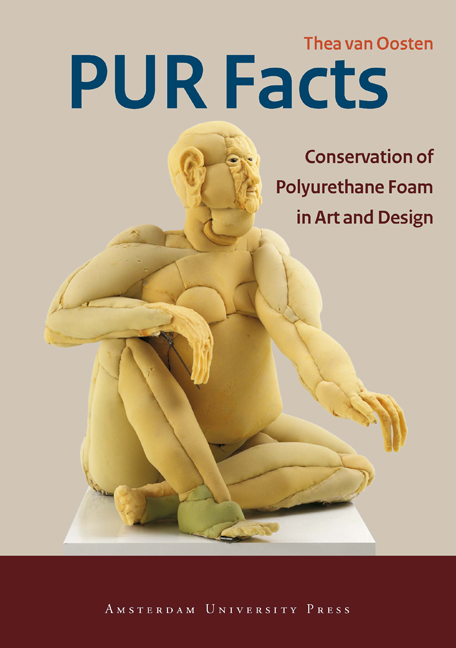Book contents
- Frontmatter
- Contents
- Preface
- Introduction
- 1 Polyurethanes, Manufacture and Applications
- 2 Chemistry, Properties and Degradation
- 3 History of Polyurethane foam Conservation
- 4 Ageing Behaviour of Polyurethane foam
- 5 Assessing the Condition of Polyurethane foam
- 6 Case Studies
- Acknowledgements
- Glossary
- General Information
- Bibliography
5 - Assessing the Condition of Polyurethane foam
Published online by Cambridge University Press: 14 January 2021
- Frontmatter
- Contents
- Preface
- Introduction
- 1 Polyurethanes, Manufacture and Applications
- 2 Chemistry, Properties and Degradation
- 3 History of Polyurethane foam Conservation
- 4 Ageing Behaviour of Polyurethane foam
- 5 Assessing the Condition of Polyurethane foam
- 6 Case Studies
- Acknowledgements
- Glossary
- General Information
- Bibliography
Summary
Condition of polyurethane ester and ether foam
Polyurethane foam used in modern and contemporary art works and design objects eventually degrades, thus confronting curators and conservators with the consequences of the limited durability of these materials: brittleness, crumbling, disintegration, deformation, cracking, delaminating and discolouration. Open (flexible) foams as well as closed (rigid) foams have a limited lifespan. In order to predict the longevity of both polyurethane ester and ether foam, the current condition and rate of decay of the object need to be ascertained. Two decades of conservation research at ICN have shown that these two parameters depend on the composition, production method and added anti-ageing components, the past life of the objects, their use and the conditions surrounding them.
Polyurethane ether foam is very sensitive to light ageing and hardly affected by thermal ageing, whereas polyurethane ester foam is vulnerable to thermal ageing and hardly affected by light ageing. A better insight into the condition of a polyurethane foam will make it easier to decide whether to consolidate or postpone consolidation treatment.
At present, there is no available consolidation treatment for polyurethane ester foams due to the fact that the consolidant needs to penetrate the foam object from top to bottom. Existing consolidation application techniques do not currently allow this. Even so, it is essential to establish the condition of a polyurethane ester foam work of art or design object in order to carry out preventive measures for this endangered material such as low RH storage.
When it is unclear whether the polyurethane foam is of the ester or the ether type, two identification methods are available: FTIR analysis which requires only a very small sample of 0.6 mm2 or by dissolving the polyurethane foam in a 10% KOH solution, which requires a sample of at least 1 mm2. Polyester urethane foam dissolves in a 10% KOH solution while polyether urethane does not. Both methods are invasive. A non-invasive identification involves NIR analysis, which does not require taking samples at all.
- Type
- Chapter
- Information
- PUR FactsConservation of Polyurethane Foam in Art and Design, pp. 81 - 90Publisher: Amsterdam University PressPrint publication year: 2011



